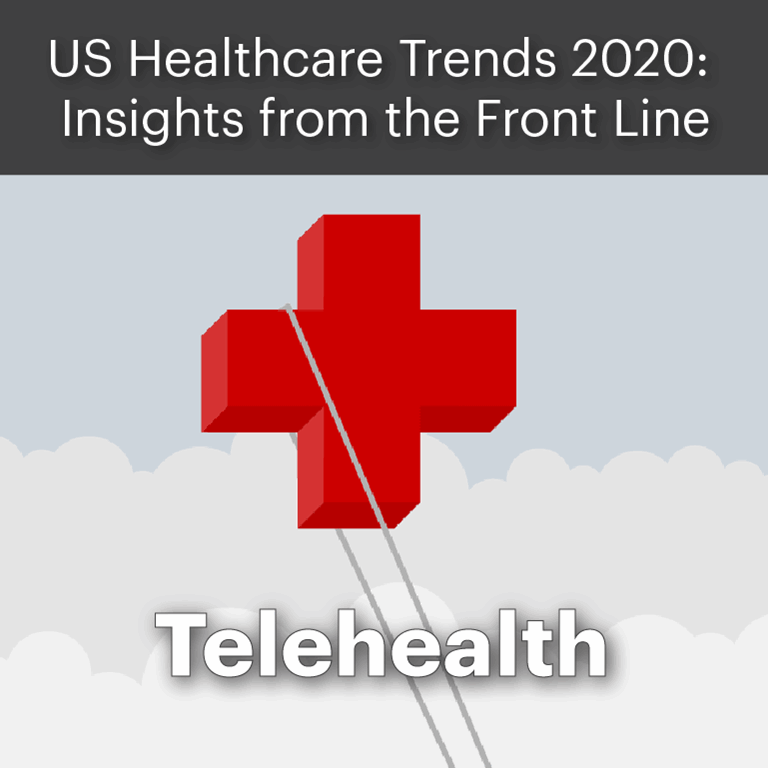Brief

Executive Summary
- More than 80% of doctors expect to use telehealth at the same or greater level than they do now, Bain research shows.
- Physicians expect to use telehealth for routine visits, chronic care and doctor-to-doctor consultations.
- Telehealth will not replace in-person visits: Eighty-two percent of doctors say telehealth will complement in-person care, according to Bain’s 2020 US Front Line of Healthcare Survey.
- Post–Covid-19, most telehealth users will opt to “see my doctor” vs. “see any doctor.”
This article is part of Bain's report US Healthcare Trends 2020: Insights from the Front Line. Explore more insights from the report here.
Covid-19 has changed the way that people interact, particularly healthcare providers and their patients. Over the last few months hospitals have canceled or eliminated elective procedures, and physicians have restricted physical access to their practices. Those trends are accelerating the adoption of telehealth services as providers and patients turn to virtual visits for safety and convenience.
Telehealth, however, is hardly a new tool. In 2019, before the pandemic, 80% of insured employees had the option to use telehealth services, but fewer than 5% did. During the Covid-19 crisis, patients and physicians embraced telehealth out of necessity, and they are likely to continue using it. Eighty-two percent of physicians report that they expect to use telehealth as frequently as they do today, or more. Comparing our 2017 and 2020 US Front Line of Healthcare Survey findings, telehealth usage has increased almost fourfold. Only 24% of physicians reported using telehealth in the 2017 survey. Now, 51% of hospital administrators and 47% of physicians in independent practices report they are “extremely willing” to invest in telehealth infrastructure.

Telehealth in the US: The Doctor Will See You Now
Covid-19 has changed how people receive medical care. Successful providers will adapt, invest and optimize digital tools to supplement quality care.
However, post–Covid-19 telehealth adoption will vary by specialty, type of visit and patient segment (see Figure 1). Physicians primarily expect to use telehealth for routine visits, chronic care and doctor-to-doctor consultations. In-person visits will still be the norm for new patient consultations and urgent care. Office-based physicians are more likely than surgeons to increase their use of telehealth, and chronic care management is more suited to a digital consultation than visits requiring physical exams.
Post–Covid-19, doctors expect telehealth to supplement in-person care
While telehealth usage will grow in the wake of Covid-19, it will not replace in-person visits: Eighty-two percent of clinician respondents to Bain’s 2020 US Front Line of Healthcare Survey reported that telehealth will complement in-person care, probably replacing mostly interactions that previously occurred over the phone. Physicians will continue to see patients in person for a majority of interactions, and use telehealth for follow-ups (see Figure 2). This is consistent with patient usage of telehealth before Covid-19. Health Affairs estimated in March 2017 that 90% of telehealth visits represented a new utilization of services (i.e., the patient would not have used health services absent a telehealth option). Accordingly, for one specialty studied, the use of telehealth resulted in an annual net increase in cost of $45 per patient.
Physicians expect to continue using telehealth for routine visits
Prior to Covid-19, patients used telehealth to “see any doctor,” primarily for urgent care needs. The pandemic expanded the use of telehealth to “see any doctor” for the acute treatment and triage of patients with the coronavirus. But it also prompted a broader adoption of telehealth, allowing patients to “see my doctor” for ongoing care of chronic conditions. This new pattern of digital engagements is likely to continue and to increase the frequency of consultations, deepening the doctor-patient relationship.
As physicians embrace telehealth for routine and urgent care, administrators are more cautious: Thirty-seven percent say they are “extremely concerned” about the economic implications of telehealth since future reimbursement rates are uncertain (see Figure 3). Also, ancillary services such as those provided by diagnostic imaging centers or ambulatory surgery centers can’t be delivered digitally. Most providers have adopted telehealth as a defensive measure in response to the pandemic. But as patients' comfort with telehealth grows, their expectations will increase. Administrators recognize that payers’ decisions on reimbursement will significantly influence providers’ profitability from telehealth services.
Hospital administrators are worried about the economic implications of telemedicine
Parity policies stipulating that a telehealth visit be reimbursed at the same rate as an in-person consultation vary from state to state and are likely to guide provider coverage of telehealth services. The Centers for Medicare & Medicaid Services (CMS) issued new guidance in March, expanding coverage and reimbursement for Medicare beneficiaries across all 50 states. Historically, coverage has been available mostly to beneficiaries living in rural locales and at different reimbursement rates than in-person visits. Going forward, providers will need to demonstrate to payers that they can generate a favorable return on investment for telehealth services to keep rate levels favorable. That could include proving that telemedicine costs less than in-person visits or provides better outcomes.
The Covid-19 pandemic has accelerated telehealth usage across the US, and virtual health services are here to stay. However, the absolute volume of digital visits will depend on the frequency and duration of Covid-19 flare-ups and insurers’ reimbursement policies. After the pandemic, when normal business volumes return, further growth will depend on providers’ ability to support telehealth demand as a complement to in-person care.

About the Research
Data powered by Dynata, a leading global first-party data and insights platform.

Insights from the Front Line
From physician burnout to telehealth, the pandemic has reshaped the healthcare landscape. Bain's series, US Healthcare Trends 2022: Insights from the Front Line, examines how the industry is confronting current challenges, including patient and physician satisfaction, the transition to value-based care, and omnichannel care.